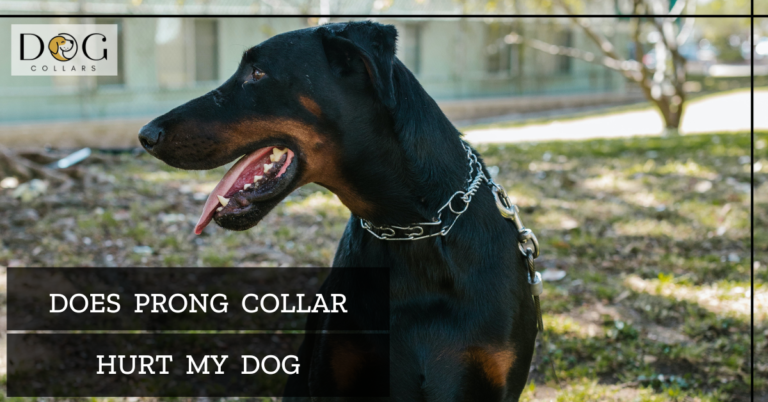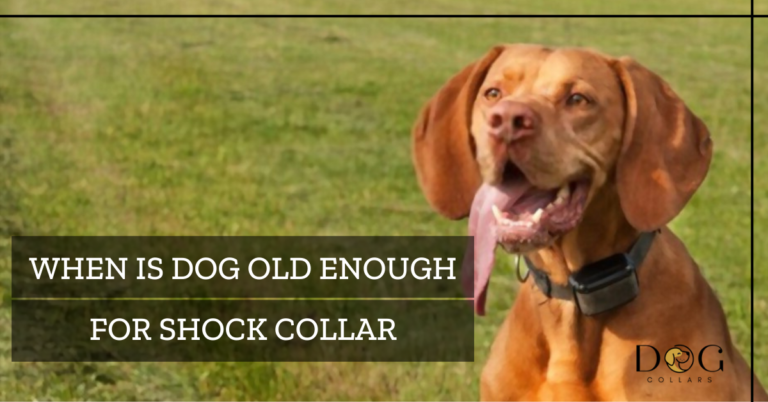How To Put A Choke Collar On A Dog – 6 Steps Guide

If you’re a dog owner, you might have heard of a choke collar, also known as a slip collar.
Before we begin, it’s important to note that we should only use choke collars as a training tool, and should not leave them on your dog unattended.
To fasten a choke collar on a doggy, choose the right size choker, position it with the chain on top, slide it over the dog’s head, close it by pulling the loose ends through the bottom ring, and check the fit.
In this article, we will guide you through the steps of how to put a choke collar on a dog safely and effectively. We will also cover some tips on when to utilize a choke collar and when to avoid it.
Now, let’s get started!
Preparing Your Dog For A Choke Collar
Before you put a slip collar on your dog, it’s important to prepare them for it. This includes getting them used to wearing a regular choker and leash and gradually introducing them to the slip collar. You should also make sure that your dog is comfortable with the choker before using it for training purposes.
How To Put A Choke Collar On A Dog – Step-By-Step Guide
To put a slip collar on your dog, follow these steps:
Choose the Right Size:
Make sure you choose a slip collar that fits your dog properly. The collar should fit snugly around the neck of your dog without being too tight or too loose.
Position the Collar Correctly:
Hold the choker with the chain hanging down, and position it so that the chain is on top of the choker.
Open the Collar:
Spread the two rings of the choker apart to open it.
Place the Collar on Your Dog:
Slip the collar over your dog’s head, and position it so that the chain is at the back of its neck.
Close the Collar:
Pull the loose ends of the collar upward and then slide them through the bottom ring of the choker to close it.
Check the Fit:
Make sure the collar fits your dog properly by placing two fingers between the collar and the neck. The collar should not be too tight or too loose.
How To Choose The Right Size Choke Collar
Choosing the right size for your dog is extremely important. The choker should be snug but not too tight, so it can properly function as training equipment without causing harm to your dog.
To determine the correct size, measure around the widest part of your pet’s neck and add two inches to that measurement. This will ensure that the choker fits comfortably without being too loose or too tight.
It’s also essential to consider the width of the slip collar. A wider one may be better suited for larger dogs with thicker necks, while a narrower one could work well for smaller breeds.
Loosening And Tightening The Collar
When using a slip collar, it’s important to understand how to properly adjust the tightness. The choker should fit snugly without restricting breathing or causing discomfort.
- To loosen the choker, simply pull on the leash and allow some slack in the chain or loop of the choker. This will release pressure from your dog’s neck and give them room to breathe more comfortably.
- On the other hand, tightening the choker should be done with caution. It’s important not to over-tighten as this can cause harm to your pet. Use gentle pulls on your leash until you see a slight reaction from your dog indicating they feel pressure.
Tips For Training Your Dog With A Choke Collar
Here are some tips for dog training with a choke/ prong collar:
- Always use a slip choker as a training tool only under professional guidance.
- Never leave a slip collar on your dog unattended.
- Use positive reinforcement techniques in conjunction with slip choker training.
- Be patient and consistent in your training.
Types Of Choke Collars
When it comes to choking collars, dog owners have a few different options.
- Chain slip collars are made entirely of metal links and feature a ring at each end that joins together with a quick-release clasp.
- These chokers tighten around the dog’s neck when pulled on, applying pressure to discourage pulling or other unwanted behaviors.
- Martingale collars look similar to traditional flat collars but have an additional loop of material that can tighten slightly when pulled on.
- This type of choker is designed for dogs who may be able to slip out of their regular flat collar because they have a smaller head than neck (such as Greyhounds).
- There are also prong or pinch collars, which use blunt metal spikes on the inside of the choker to apply pressure rather than just squeezing around the neck like chain slips and martingales do.
Common Mistakes When First Using A Choke Collar
- One of the mistakes is using too much force when pulling on the leash attached to the dog slip choker.
- Some people also use a choke chain instead of a proper slip choker, which can be dangerous as it doesn’t have a stopper like most neckbands do.
- Additionally, some people may rely solely on the dog chain collar for training their dogs without teaching them basic obedience commands first.
- Neglecting proper maintenance of your choking device by constantly failing to readjust it may prove harmful to you. It can also prove harmful to others who handle such devices, both physically and mentally.
The Do’s And Don’ts Of Choke Collars
Here are some important dos and don’ts of using dog collars safely and effectively:
- Do use only under the guidance of a professional dog trainer.
- Don’t use the choker on a dog that is too young or too small.
- Do use positive reinforcement techniques in conjunction with slip choker training.
- Don’t use it as a punishment tool.
- Do make sure the choker fits your dog properly.
- Don’t leave a choker on your dog unattended.
Why Is It Necessary To Put A Choke Collar Properly?
It’s important to put a choker on your dog properly to ensure that they are not harmed or traumatized during training. A poorly fitting chain collar can cause pain, discomfort, and injury to your dog, and can make training more difficult and less effective.
Conclusion
Putting a choke collar on a dog requires proper preparation, fitting, and training techniques to ensure the safety and well-being of your dog.
By following the step-by-step guide, using positive reinforcement techniques, and avoiding common mistakes. You can effectively train your dog to walk on a leash without pulling on straining.
Remember to always use slip collars under the guidance of a professional dog trainer, and to prioritize your dog’s comfort and safety during training. With patience and consistency, pinch collars can be a valuable tool for training your dog and enjoying many happy walks together.
FAQs:
Are Choke Chains Safe?
Choke chains can be harmful and even dangerous for dogs if not used properly. They can cause injury, discomfort, and behavioral problems. So it’s important to seek professional guidance and consider alternative training tools.
Do Choke Chains Stop Pulling?
Choke chains may temporarily stop a dog from pulling. They do not address the underlying behavior and can cause harm and discomfort to the dog.
Should I Use a Choke Chain on a Puppy?
We do not recommend using a choke chain on a puppy as it can cause physical harm and may not effectively train your puppy. Positive reinforcement training methods are generally more effective and humane.
Where Should You Attach a Choke Chain Collar?
A choke chain collar should be attached high up on your dog’s neck, just behind their ears, to ensure proper control and to avoid injury to the trachea or other sensitive areas.
Do Dog Trainers Use Choke Collars?
Some dog trainers may use pinch collars as a training tool, but there are alternative methods that do not rely on aversive techniques.
Is a Choke Collar Better Than a Harness?
Neither is universally better than the other as it depends on the individual dog and their training needs. A slip collar can be effective for certain types of training. But a harness is generally safer and more comfortable for the dog’s neck and spine.
What Is A Dog Choke Collar?
A dog pinch collar is a type of training collar that tightens around a dog’s neck when pulled, designed to provide gentle correction while on a leash.
How Should You Place a Prong Collar on a Dog?
To put a prong collar on a dog, adjust it to the correct size, position it high on the dog’s neck with prongs facing inward, and make sure it’s snug but not too tight.






